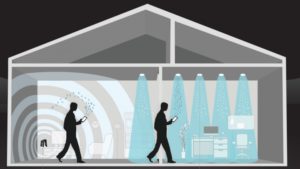What is Li-Fi Technology?
Li-Fi (Light Fidelity), which is expected to replace Wi-Fi technology in the future, is a wireless connection technology that uses LED bulbs and visible lighting devices to transfer data and communicate wirelessly between devices. It aims to present data using light waves instead of the radio signals used by Wi-Fi. Since Wi-Fi technology, which has been used for years, is now insufficient in many places, we can say that the heart of the technology is now beating for Li-Fi, which is called a “revolution in wireless connection.” It is a system, also known as Visible Light Communication. This technology uses light because it is easier to focus signals in one place. In this way, there will be a faster data transfer situation.

How does Li-Fi work?
In Li-Fi technology, LED bulbs that illuminate our environment will also provide us with wireless internet access. This aims to act as a data transfer provider, with LEDs turning on and off at speeds that our eyes cannot perceive. The devices will have Li-Fi receivers and the information from the LEDs will be processed bilaterally. In other words, the devices will both receive information from the flashing of the LEDs and send information to the LED bulbs themselves. For this, LED bulbs will not be the ones we currently use in homes or workplaces, they will be bulbs developed to support this technology. Likewise, we will need to use Li-Fi compatible devices in devices such as mobile phones, laptops and tablets that we currently use in our homes and workplaces.
By clicking on this site, you can be informed about the latest developments about this technology: Li-Fi news

Data flow in Li-Fi technology:
If the light source of this technology is turned off, the data flow is automatically interrupted. Therefore, the lighting systems must be constantly on for data transfer to continue. For this, it is necessary to put a stable LED bulb in each room. Li-Fi uses visible light instead of radio signals. For this wireless connection technology to work properly, it is necessary to have a photodetector that receives the light and hardware that can process the signal and make the data transmittable.
Advantages of Li-Fi technology:
- While data is transferred at 2 Gbps per second with Wi-Fi, 224 Gbps per second can be reached with Li-Fi. By providing the lighting task and data transfer through a single device, it provides energy savings close to 100 times. It will not cause problems that negatively affect people’s health, such as Wi-Fi. The Wi-Fi signals you use in your environment may interfere with other nearby wireless connection signals, causing disruptions in connections and devices. Since Li-Fi technology is more secure, such problems will not occur.
- It can easily provide wireless internet access wherever LED bulbs are used. In other words, the use of this technology in aeroplanes, rural areas, hospitals and military areas where Wi-Fi technology is insufficient will provide great convenience. So, it seems that LED bulbs will be a part of this technology in the future, changing a little shape and function.
- It has a spectrum 10,000 times wider than a Wi-Fi network. This means that Li-Fi technology is a longer-lasting and reliable wireless network technology than Wi-Fi. The frequent disconnections in Wi-Fi technology will not occur in Li-Fi. Therefore, the data transfer will take place safely.
Disadvantages of Li-Fi Technology:
- The Internet cannot be used without a light source. This may limit the places and situations where Li-Fi can be used.
- Since it uses visible light and light cannot penetrate walls, the range of the signal is limited by physical barriers.
- Other light sources may interfere with the signal. One of the biggest potential drawbacks is capturing outside signals. Sunlight will affect the signals, causing Internet interruption.
- Considering that most of the existing infrastructure is built to accommodate RF technology, replacing all that infrastructure to accommodate newer technology can be very costly and exhausting.
As a result, looking at the comparisons between WiFi and LiFi, now it would be very difficult to choose one over the other as both have their advantages and disadvantages. Therefore, a different mindset should be adopted and these pieces of technology should be looked at differently. In the future, we will see together whether Li-Fi is a disruptive technology and whether it will completely replace wifi.











